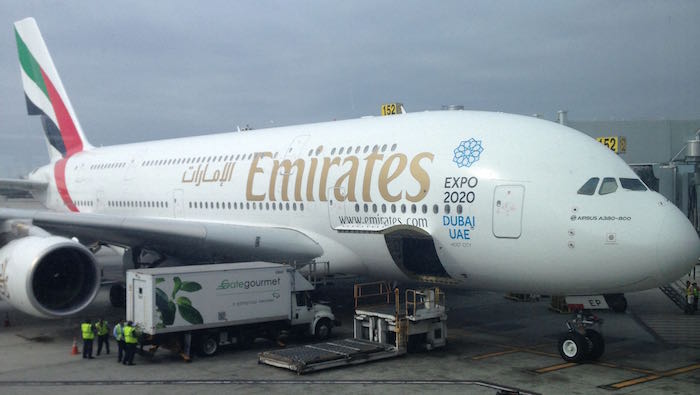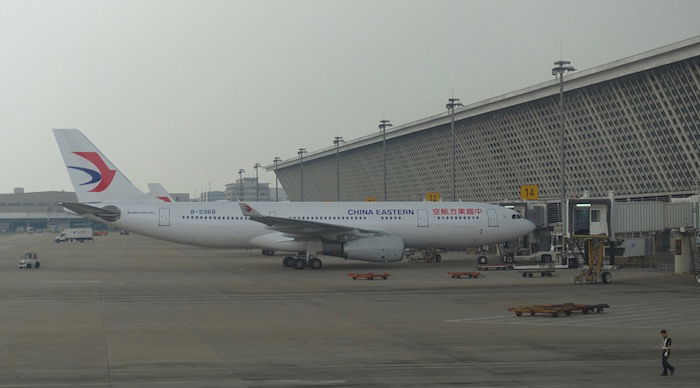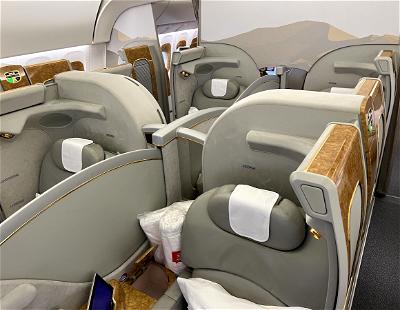Emirates has reported a 75% drop in their net profits for the first half of the fiscal year, to $214 million.
Looking at the numbers behind Emirates’ reduced profits
It’s interesting to see how various factors at Emirates have changed from one year to the next. Arabian Business has all the details on that, specifically comparing the results over the course of the first half of two fiscal years:
- Revenue was down by 1%, from $11.5 billion to $11.4 billion
- Fuel costs were 10% lower than the previous year, comprising 24% of the airline’s operating costs (compared to 28% the previous year)
- Operating costs grew by 5%, while overall capacity grew by 9%
- Average load factors were 75.3%, compared to 78.3% the previous year
- Passenger traffic (measured in available seat kilometers) was up by 8%, while capacity in the same unit of measure was up 12%

So, what’s causing the reduction in profits?
The Gulf carriers are largely responsible for the challenging environment that traditional airlines around the world are facing, due to the increased competition they’ve provided. This has hit carriers in Europe and Asia especially hard, as Emirates has been able to capture much of the market share between those continents.
However, the Gulf carriers face many of the same challenges that other carriers around the world face:
The airline attributed the drop in profit and revenues to the unfavourable currency environment and increased competition resulting in lower average fares.
In particular, it was impacted by currency devaluation and hard currency shortage in some African countries, as well as dampened travel demand due to ongoing economic uncertainty and security concerns across several markets in its network, the statement said.
“Increased competition, as well as the sustained economic and political uncertainty in many parts of the world has added downward pressure on prices as well as dampened travel demand.
“The bleak global economic outlook appears to be the new norm, with no immediate resolution in sight. Against this backdrop, the Group has remained profitable and our solid business foundations continue to stand us in good stead.
Gulf carriers and “profits”
As most of you probably know, the US and Gulf carriers have long been fighting over their air agreements, with US carriers arguing that they’re not on a level playing field with the “subsidized” Gulf carriers.
Personally I side mostly with the Gulf carriers, or at least don’t side with the highly convenient argument the US carriers make, where they complain of subsidies but only target three Gulf carriers, and not the hundreds of other subsidized airlines around the world (Delta has no problem partnering with subsidized Saudia, and has also bought an equity stake in China Eastern, which is subsidized as well… but that doesn’t fit their narrative).

Regardless of that, I think it’s safe to say that the math in the Middle East is a little bit different when it comes to airline profitability. In other words, the above profitability figures likely don’t factor in financing costs, the actual costs of running airports, etc. To me that doesn’t really matter, but the point is that a $214 million profit at a Gulf carrier looks a bit different than a $214 million profit at a US carrier.
However, based on everything I’ve seen, if there’s a Gulf carrier that makes money it’s definitely Emirates, given that they’ve managed to scale their operation to their point that I genuinely believe they might be profitable. However, I wouldn’t put too much weight into any of the profitability figures they provide.
Bottom line
It’s not surprising to see the Gulf carriers struggle in light of lower oil prices, counterintuitive as it may seem for an airline. This has lead to reduced yields in their home market, and also has allowed other carriers to compete with them better. It’ll be interesting to see what the Gulf carriers look like a decade from now…





Agree with Frank in 60's and 70's most of the national airlines were subsdized by their government to provide air service to their citizens .
I used to be a very loyal Emirates customer out of Switzerland, but Qatar and Etihad have now consistently offered significantly better rates to key destinations in Business Class, so I booked my last few travels and two upcoming travels with them. The ME3 are first and foremost now outcompeting themselves in key locations, which hurts them but of course also continues to hurt (ex-ZRH) also SWISS, Singapore Airlines and Cathay eastbound.
Maybe they don't make as much money from their first class now that Alaska will barely sell their awards at the actual rates. I would like to see what the average occupation in first is since that day compared to before.
Emirates has way too many A380s, and not enough A350's and 787's to match properly match seats with demand. As it now stands, they need to whore out the back of the plane at or near cost just to pay the operating costs. When I was at NW, it was our intention to retire the entire 747-400 fleet (16 planes at the time) and replace them with smaller 787s. We could fill the 747s, but...
Emirates has way too many A380s, and not enough A350's and 787's to match properly match seats with demand. As it now stands, they need to whore out the back of the plane at or near cost just to pay the operating costs. When I was at NW, it was our intention to retire the entire 747-400 fleet (16 planes at the time) and replace them with smaller 787s. We could fill the 747s, but only at prices that did not generate a reasonable return on the investment. Flying the flag is the major concern for the ME3; not revenue management. They're good airlines, but they're not efficiently run companies with public stockholders to answer to.
"The Gulf carriers are largely responsible for the challenging environment that traditional airlines around the world are facing, due to the increased competition they’ve provided."
Worded as if we are supposed to feel bad for the "traditional airlines". And btw, wth is a "traditional airline" anyways?
Financing goes on the cash flow statement, not on the income statement which in English means financing costs have nothing to do with profitability.
Air India is eating into Emirates' loads. AI intl flights have improved their load factors significantly meanwhile..
Lot of airlines around the world are subsidized to provide air services to their citizens, developed countries did long back and developing countries doing it now.
But ME3 subsidies are used to take down competition. Reason why US3 are OK with other subsidies and NOT OK with ME3 subsidies.
Capacity is up 9% -- while load factors are down three percentage points and total revenue is down 1%.
That tells me they are over expanding. They have way more capacity than they did a year ago but they couldn't fill as many seats on each flight -- and they had to heavily discount the seats they did fill, so even with a huge expansion in capacity and correspondingly higher operating costs, they got no...
Capacity is up 9% -- while load factors are down three percentage points and total revenue is down 1%.
That tells me they are over expanding. They have way more capacity than they did a year ago but they couldn't fill as many seats on each flight -- and they had to heavily discount the seats they did fill, so even with a huge expansion in capacity and correspondingly higher operating costs, they got no incremental revenue. In fact revenue actually went down a bit.
I know there is some room for revenue to go down at airlines given how low fuel prices are -- but plummeting load factors with massive capacity expansion is not healthy. And the fact that they just make excuses for themselves, blaming currency, is not a good sign either. What they're really saying is they were planning for explosive growth -- but that didn't materialize.
Emirates will probably be fine since the government will just quietly "loan" then more money (I.e., bail them out). But from a financial perspective these are not numbers you would see at a healthy, well-run airline. Looks like a typical state-run, inefficient operation frittering away money in the speculative hope that massive spending will eventually lead to revenue growth.
I agree with Lucky that the U.S. government should not intervene, but I can see why U.S. airlines are pissed about irresponsible competitors like this. No one can make money if a few airlines are willing to spend like crazy because a bail out is always just a phone call away.
Revenue: AED46.5 billion (USD12.7 billion), +1% year-on-year;
Emirates: AED41.9 billion (USD11.4 billion), -1%;
dnata: AED6.0 billion (USD1.6 billion), +14%;
Profit: AED1.3 billion (USD364 million), -64%;
Emirates: AED786 million (USD214 million), -75%;
dnata: AED549 million (USD150 million), -1%;
Passenger numbers: 28.0 million, +9%;
Passenger load factor: 75.3%, -3.0 ppts